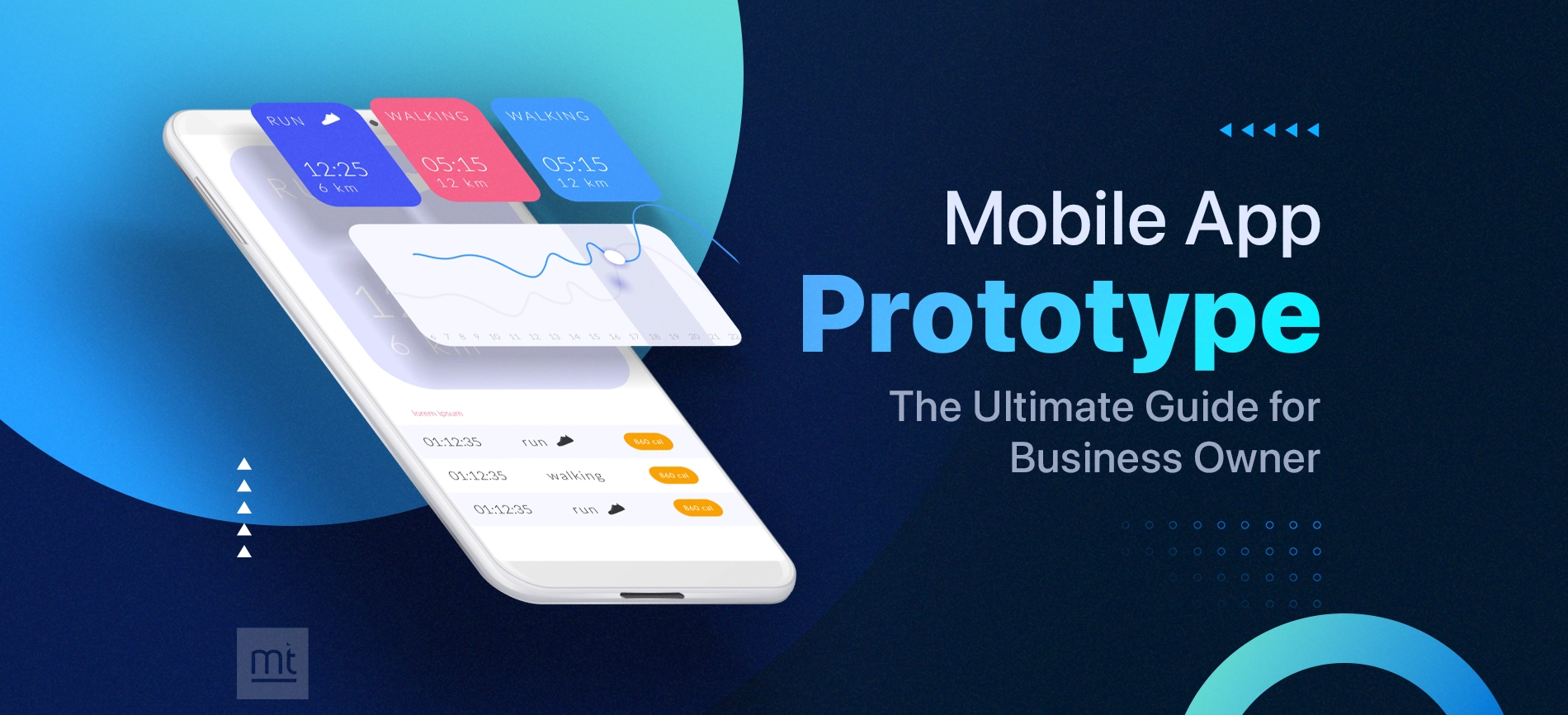Introduction:
The mobile application market is growing like there is no end, giving businesses the upper hand in delivering convenience to customers. With this comes the rise of Progressive Web Apps (PWA). It is delivering a new center edge for businesses, allowing them to shape their online presence in the modern world. This type of application combines a regular web application with a native mobile application.
Today, businesses settle for applications with faster time to market and appealing and stable options, which makes Progressive Web Apps the ideal choice to win every bet.
With PWA, you give customers next-level convenience, from offline access to better responsiveness and so on, to fulfill every need. Here, we will cover the rise of PWA and how it is closing the gap between web and mobile applications.
What are Progressive Web Apps (PWAs)?
The PWAs are the next generation of web pages coupled with native Web applications, which have a new web development method. Contemporary web technologies allow PWAs to provide a web application atmosphere as an app in a browser without downloading an app. Via service workers for offline working, app shell architecture for lightning-quick loading, and push notifications for direct user contacts have proven consistent, more speedy, and compelling.
Benefits of Progressive Web Apps (PWAs) for high-end Web Solutions
Progressive Web apps are the perfect way for businesses that enable them to bring their product and service to their customer's fingertips. Here is the list of benefits of PWAs that make it a perfect choice for developing high-end applications:
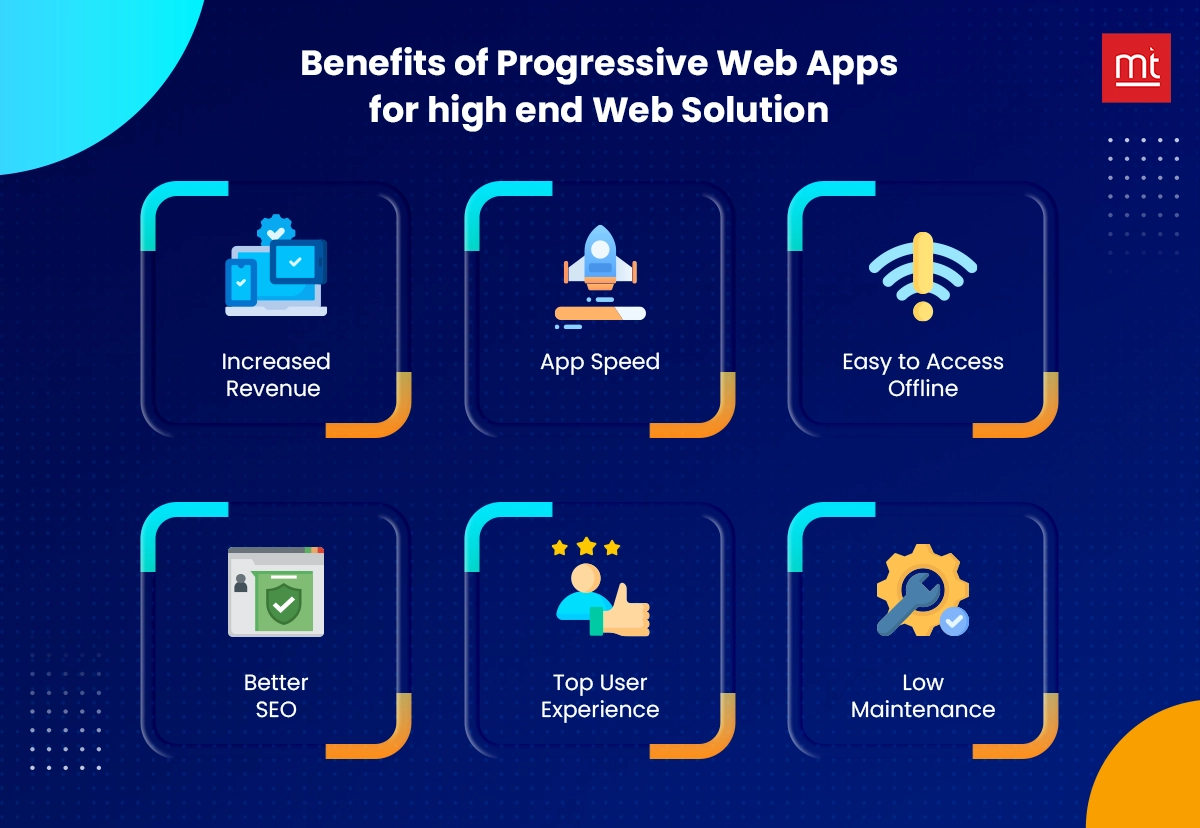
1. Cross-platform
Cross-platform interoperability is one of the main benefits of PWAs and can be accessed on any device or operating system through HTML, CSS, and JavaScript. In contrast to native applications that require a specific environment, PWAs can be launched on web browsers on computers, tablets, and smartphones.
2. App Speed
Web applications require speed, and PWAs are architecture-wise created to meet this requirement. One of the characteristics of PWAs is that they have a background script known as a service worker, which runs the PWA irrespective of the web page. Even in places with internet outages, workers can cache key resources offline so the app can load quickly in the future.
3. Easy to Access Offline
Having an online presence is also one of the PWA advantages. Conventional web applications require constant internet access, which could be a hurdle for users with poor connections. The PWAs are designed to be used offline or with minimal internet bandwidth.
4. Better SEO
SEO is a significant source of organic website traffic, and PWAs provide effective SEO aspects. Search engines go through and come across PWAs as web pages. This is a benefit compared to native applications that are found in app stores and unsearchable from the internet.
5. Top User Experience
Any successful apps are built on the foundations of user experience (UX), and PWAs are experts on that topic. PWAs are intended to provide a similar feeling as apps do in the browser. They can send push notifications, be installed on a user's home screen, and open in full-screen mode; therefore, they exhibit the behavior of the native applications.
6. Low Maintenance
Keeping the platform-specific native apps is very costly and time-consuming. PWAs reduce maintenance costs by merging development and maintenance into one codebase. This all-inclusive process simplifies the updates and ensures every user gets the latest features and improvements, regardless of their device.
Key features of Progressive Web Apps (PWAs) to Make it Ideal Choice
Key features are what set development choices stand out. When it comes to features, PWA brings a lot to the table, giving cutting-edge choices for businesses to stand out with world-class development. Here are the best features of Progressive Web Apps that make it a reliable choice for businesses:
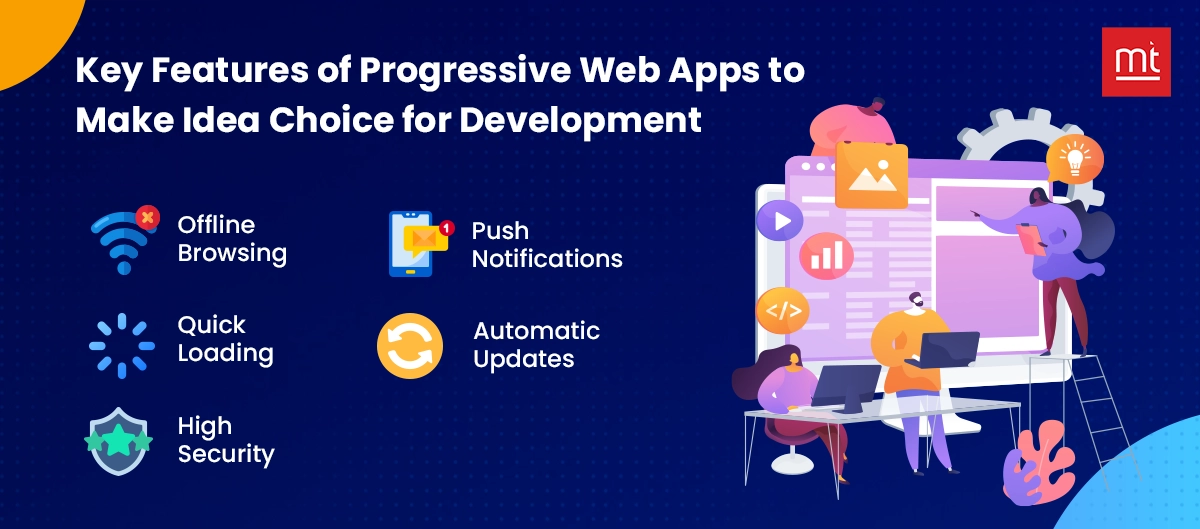
1. Offline Browsing
Offline browsing is the feature that sets Progressive Web Apps apart from normal web apps. The service workers' background scripts that cache HTML, CSS, JavaScript, and other related materials are the ones that can grant this function. Once a user opens the app, the service worker checks for cache and sends resources to it so that it can work without an internet connection.
2. Push Notifications
Push notifications make the users to be involved and use the app. PWAs use push notifications to send the users real-time updates, alerts, and designed messages even when the app is not being used. This characteristic tells people about important events, new content, promotions, and so on and keeps them connected with the app.
3. Fast Loading
PWAs are fast to load, so the user will not notice any delay in their interaction. Service workers and good caching solutions make PWAs fast to load. By caching the application shell and static resources, PWAs load quickly on subsequent visits, even on slow or unstable networks.
Research shows that users will stop using an app that takes longer than a few seconds to load.
4. Automated Updates
PWAs may be updated autonomously without user participation, a significant advantage over native applications. Getting updates for regular programs manually is time-consuming and can be a real hassle. PWAs may update in the background while the user is online, thus keeping the app updated with new features, bug fixes, and security updates.
5. High-security
Web and mobile app developers put security first, and PWAs are armed with advanced security tools to protect user data and make safe interactions. PWAs must be served over HTTPS to prevent man-in-the-middle attacks and thus protect the data. This secure connection makes the user feel more confident, mainly for apps that deal with sensitive information such as financial transactions, personal data, and login passwords.
Challenges And Limitations Of PWAs
Here are some crucial limitations to PWA that will help you make an informed choice regarding PWAs:
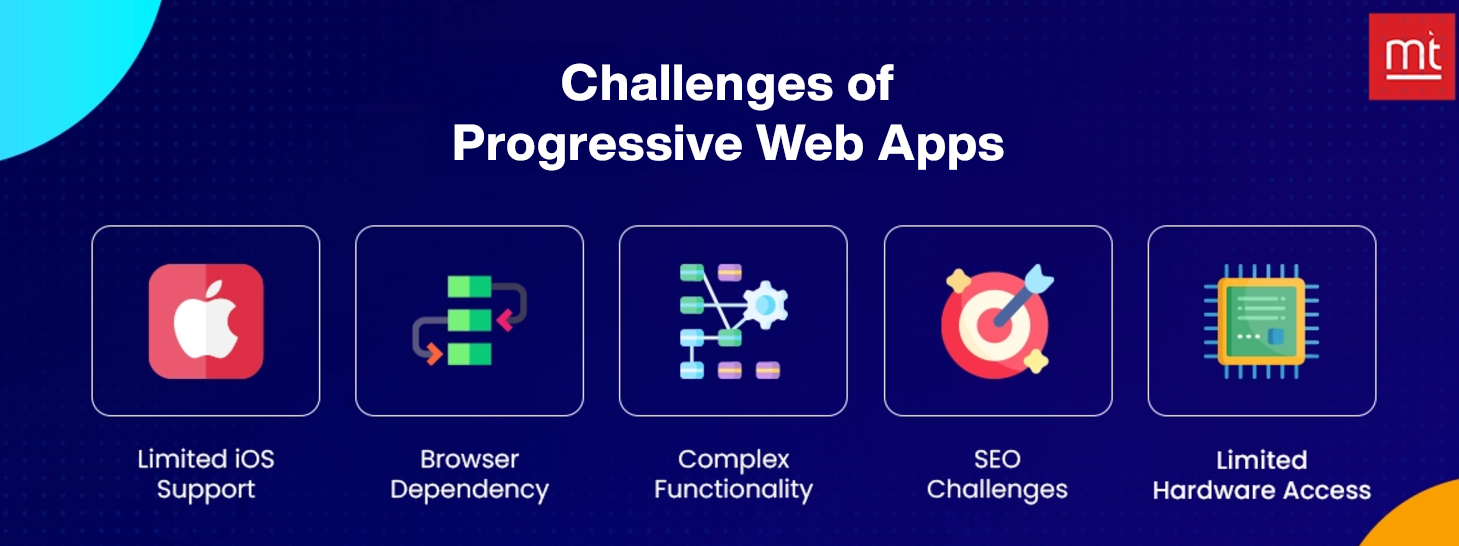
- Limited iOS Support: Having limited functionality on iOS devices is a major challenge for PWAs. Many iPhone and iPad users use Apple Safari, which does not fully support PWAs.
- Browser Dependency: Though PWAs are cross-platform, they primarily target Android users. These browsers aren't compatible with other browsers like Edge or Safari. PWA support is currently being developed for these browsers.
- Complex Functionality: Progressive Web Apps are not always able to match native apps in terms of functionality. In other words, users may not be able to find all the features they want, resulting in a negative user experience. As an example, PWAs perform worse in areas without access to the internet than native apps.
- SEO Challenges: There are several SEO challenges associated with implementing PWAs. An important challenge is ensuring that search engines are able to crawl and render your website properly. As PWAs use JavaScript, it can be difficult to make sure crawlers can access all the content.
- Limited Hardware Access: There are a variety of concerns regarding their uniqueness. PWAs are still not supported by all hardware and software platforms. There are currently no home screen shortcuts or progressive web app notifications available for iOS. With PWAs, a number of advanced features, such as GPS support, smartphones with cameras, and biometrics, cannot be accessed.
Real-time Examples of Businesses using Progressive Web Apps (PWAs) for Web Solutions
Many businesses have already introduced progressive web apps (PWAs) to their web solutions, and as a result, the user experience has improved, and engagement is on the rise.
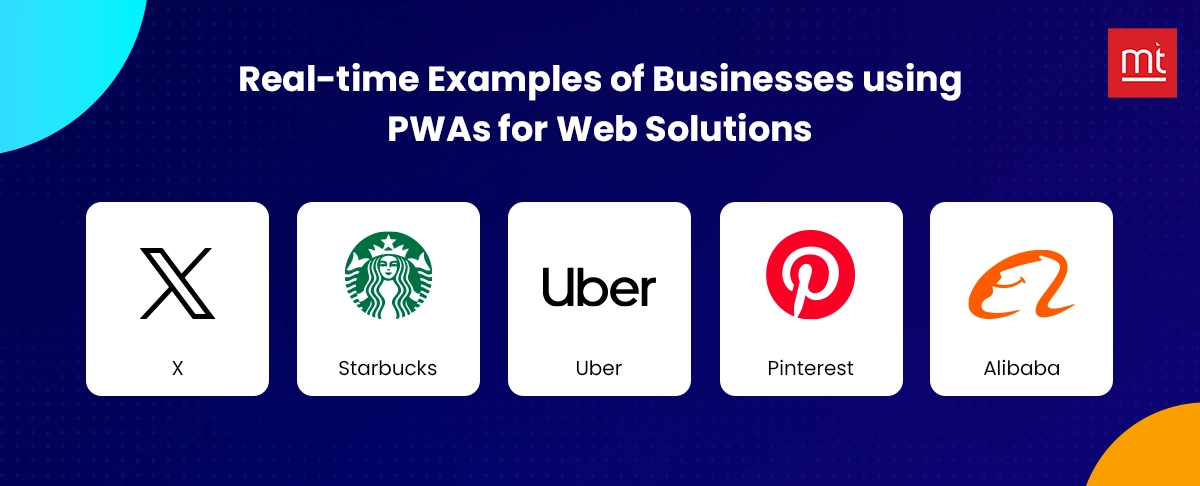
1. Twitter
The global progress of how progressive web apps (including PWAs) have altered user experiences and engagement is epitomized by Twitter Lite. Through its clever design, the app was specifically meant for mobile phones, making it an efficient tool for people living in places with slow or unreliable internet. In addition, PWA makes it easier for you to reach the social network since it is optimized for speed and data saving. Perplexity ensures you are still connected even when your internet connection is poor. Twitters Lite one such standout features is the ability for push notifications; thus keeping people up-to-date on new tweets, messages and more at all times (like an app). Besides, the PWA allows offline access such that users are able to view previously opened content and interact with it even when there is no internet connection. This is especially important for those who live in areas with interrupted connectivity because it ensures she continues having a smooth sailing throughout.
2. Starbucks
Starbucks’ progressive web application (PWA) is one of the best case scenarios for organizations using recent web techs to improve clients’ interaction with them as well as enhance their participation rates. The Starbucks PWA seeks to offer a smooth and effortless use to its clients considering places having little or no internet connection at all.
Those who are always moving around or in places where the internet connection may not be good find this particularly advantageous. In case one may be offline, they can still go through the menu and even add stuff to cart. This helps to avoid delays when ordering food because once online again; a user can make their order without any stress.
3. Uber
Uber’s progressive web app (PWA) is one of the best examples showing how modern web technologies are improving service delivery and user experience especially in places with slow internet connections. The lightweight nature and speed of Uber’s PWA guarantees that users can order rides efficiently even when their bandwidth is limited. The functioning of this app resembles that of native applications; thus it has a clean and responsive interface characterized by minimal loading times.
4. Pinterest
The user experience and engagement metrics of Pinterest have been significantly transformed by its adoption of a progressive web app (PWA). By switching to a PWA, Pinterest enhanced its websites’ performance leading to notable increases in core engagement metrics. Users now experience faster loading times and a more responsive interface which contribute to smoother browsing experiences. This improvement in performance led to 60% increases in key engagement indicators like interactions and user activity on the platform.
5. Alibaba
Implemented by Alibaba, progressive web application (PWA) has greatly enhanced business performance, especially by improving user shopping experiences. It was created to deliver a speedy, dependable and captivating shopping experience to users using even the slowest network connections. The PWA provides an incredibly responsive design that loads very fast so customers can easily browse products, purchase them or interact with the platform at ease. One of its major benefits is that it runs well under all network conditions which is particularly important for individuals living in areas where internet access is scarce.
Conclusion
Progressive web apps are a major breakthrough in web technology and are the best alternative to traditional web and native mobile applications. By integrating these two platforms, PWAs offer a quick, reliable, and entertaining user experience while reducing development expenses and complexity. Since the browsers and web standards are still changing, the possibility of PWAs changing the digital landscape is great. Companies implementing PWAs will greatly increase their performance, reach, and user engagement, making them crucial technologies for future web and mobile app development.
About Author
Subscribe to Our Newsletter!
Join us to stay updated with our latest blog updates, marketing tips, service tips, trends, news and announcements!


